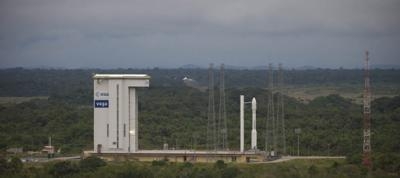Tue, Jan 31, 2012
Launch Window Opens February 9th
ESA’s new Vega rocket is now fully assembled on its launch
pad. Final preparations are in full swing for the rocket’s
inaugural flight from Europe’s Spaceport. The launch window
opens on February 9th. The upper composite, comprising LARES,
ALMASat-1, seven CubeSats, the payload adapter and the fairing, was
moved to the pad late Monday night. A night transfer is the
standard practice in Kourou to avoid overheating the payloads.

The move ended early Tuesday morning with its installation on
the dedicated stand inside the mobile gantry to await mating with
the launcher. The composite was then added on top of Vega’s
AVUM fourth stage to finalise electrical connections and verify
links, concluding with the final mechanical connection.
The main remaining steps to the maiden flight are the final
checkout of the assembled vehicle, the full launch countdown
rehearsal and the fuelling of the restartable AVUM.
This first flight, dubbed VV01, marks the end of nine years of
development by ESA and its partners, Italian space agency ASI,
French space agency CNES and industry. It will lift off from the
new Vega launch site at Europe’s Spaceport in Kourou, French
Guiana, carrying nine satellites into orbit. The launch window
opens on February 9 and ends a few days later. The mission will
qualify the overall Vega system, including the vehicle, the ground
infrastructure and operations from the launch campaign to the
payload separation and disposal of the upper module. In particular,
it will demonstrate the vehicle’s performances and payload
services in flight.
Vega will provide Europe with a safe, reliable and competitive
capacity to carry science and Earth observation satellites into
orbit, while perfectly complementing the heavy Ariane 5 and medium
Soyuz rockets already launched from the spaceport. The rocket is
designed to cope with a wide range of missions and payload
configurations in order to respond to different market
opportunities and provide great flexibility.
Unlike most small launchers, Vega is able to place multiple
payloads into orbit. In particular, it offers configurations able
to handle payloads ranging from a single satellite up to one main
satellite plus six microsatellites. It is compatible with payload
masses ranging from 660 to 5,500 pounds, depending on the type and
altitude of the orbit required by the customers. The benchmark is a
3,300 pound payload into a 435 mile-altitude polar orbit.
More News
Also: B-29 Superfortress Reunion, FAA Wants Controllers, Spirit Airlines Pulls Back, Gogo Galileo Van's Aircraft posted a short video recapping the goings-on around their reorganiz>[...]
Light Gun A handheld directional light signaling device which emits a brilliant narrow beam of white, green, or red light as selected by the tower controller. The color and type of>[...]
"The journey to this achievement started nearly a decade ago when a freshly commissioned Gentry, driven by a fascination with new technologies and a desire to contribute significan>[...]
"Our driven and innovative team of military and civilian Airmen delivers combat power daily, ensuring our nation is ready today and tomorrow." Source: General Duke Richardson, AFMC>[...]
Aircraft Conflict Predicted conflict, within EDST of two aircraft, or between aircraft and airspace. A Red alert is used for conflicts when the predicted minimum separation is 5 na>[...]
 Airborne 04.16.24: RV Update, Affordable Flying Expo, Diamond Lil
Airborne 04.16.24: RV Update, Affordable Flying Expo, Diamond Lil ANN's Daily Aero-Term (04.20.24): Light Gun
ANN's Daily Aero-Term (04.20.24): Light Gun Aero-News: Quote of the Day (04.20.24)
Aero-News: Quote of the Day (04.20.24) Aero-News: Quote of the Day (04.21.24)
Aero-News: Quote of the Day (04.21.24) ANN's Daily Aero-Term (04.21.24): Aircraft Conflict
ANN's Daily Aero-Term (04.21.24): Aircraft Conflict



